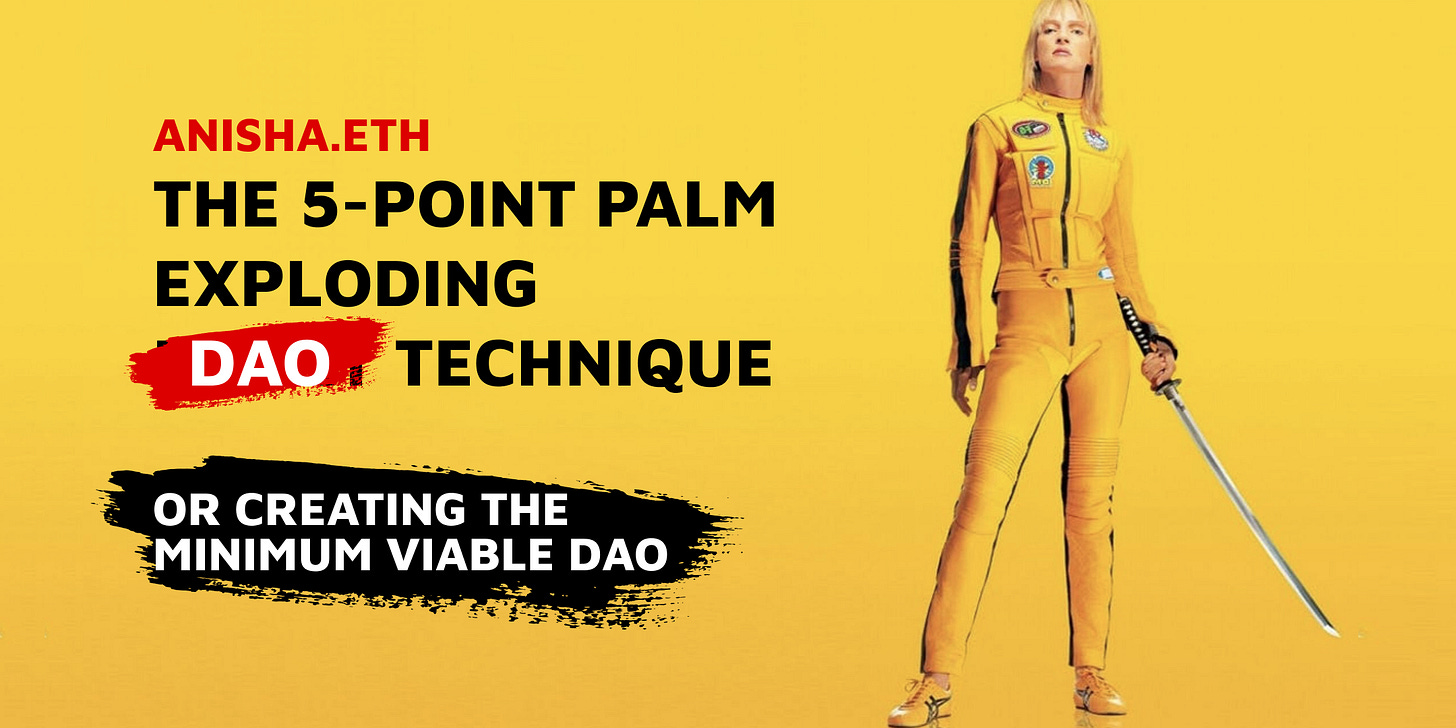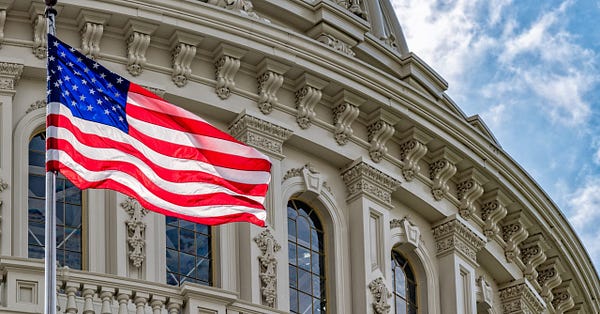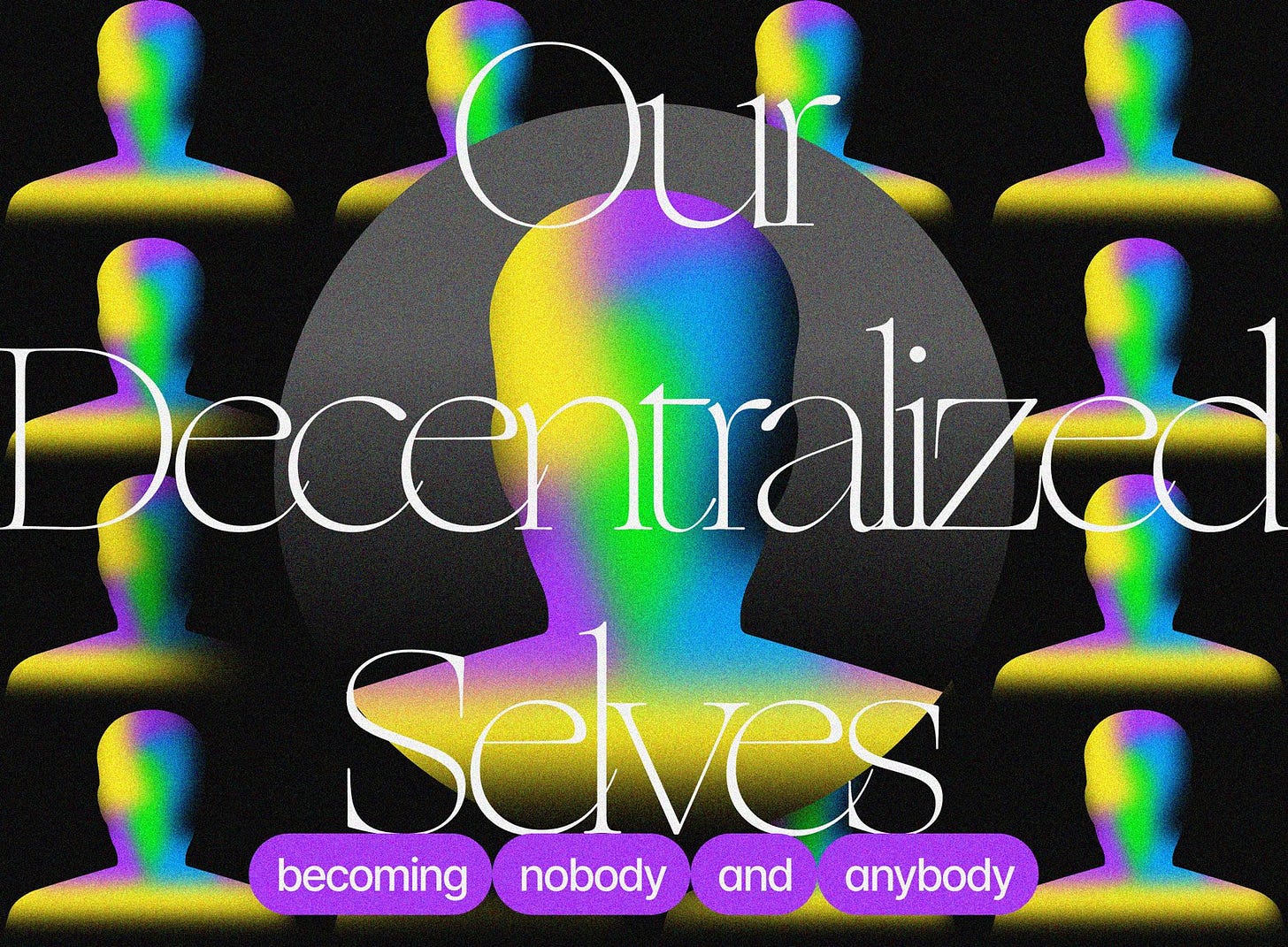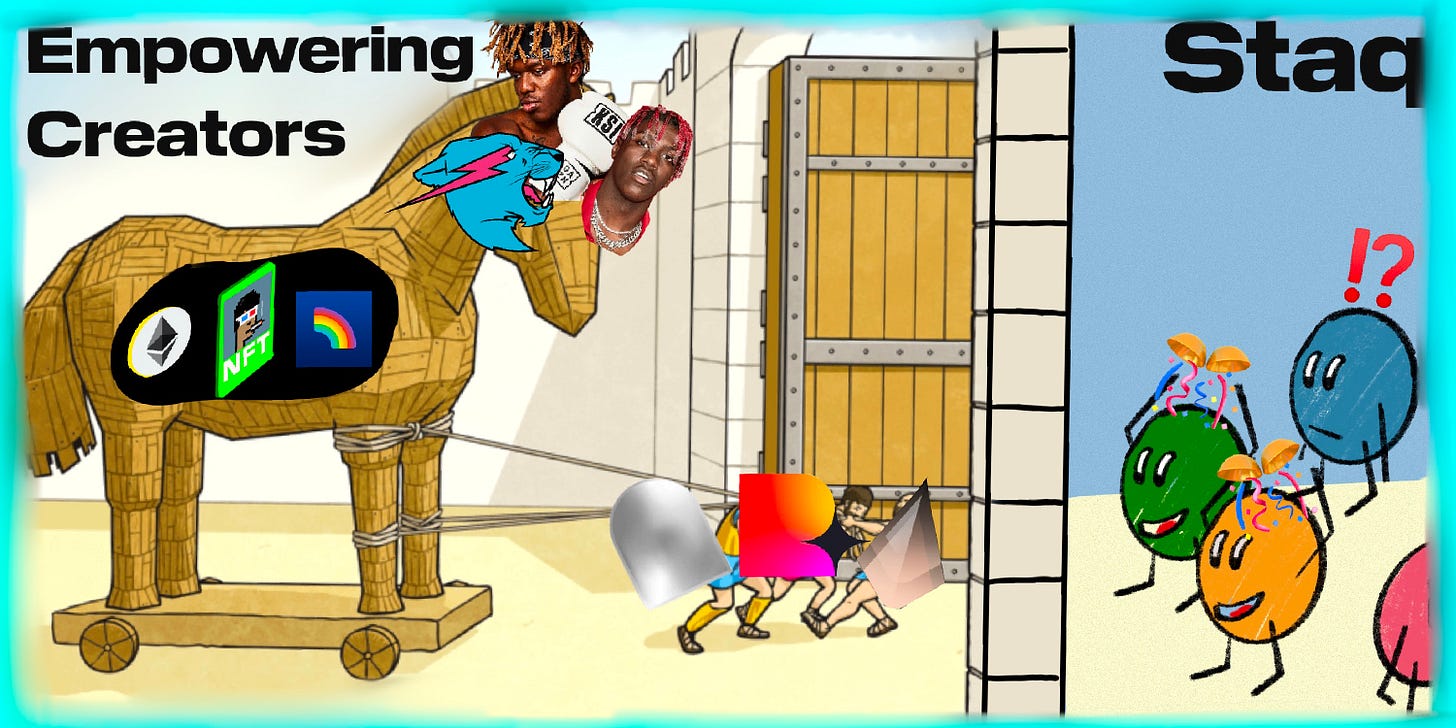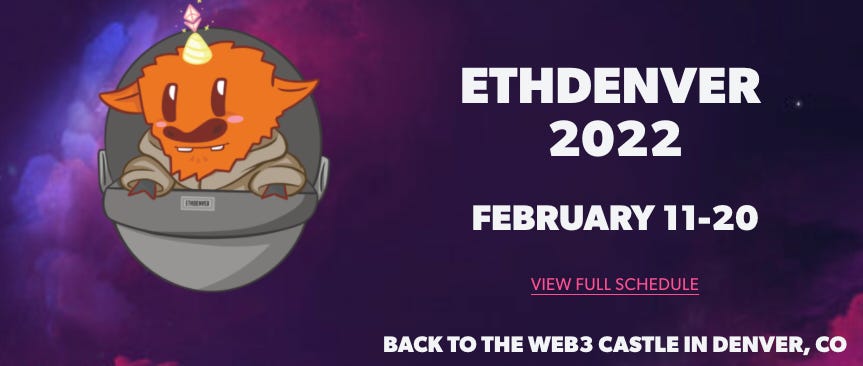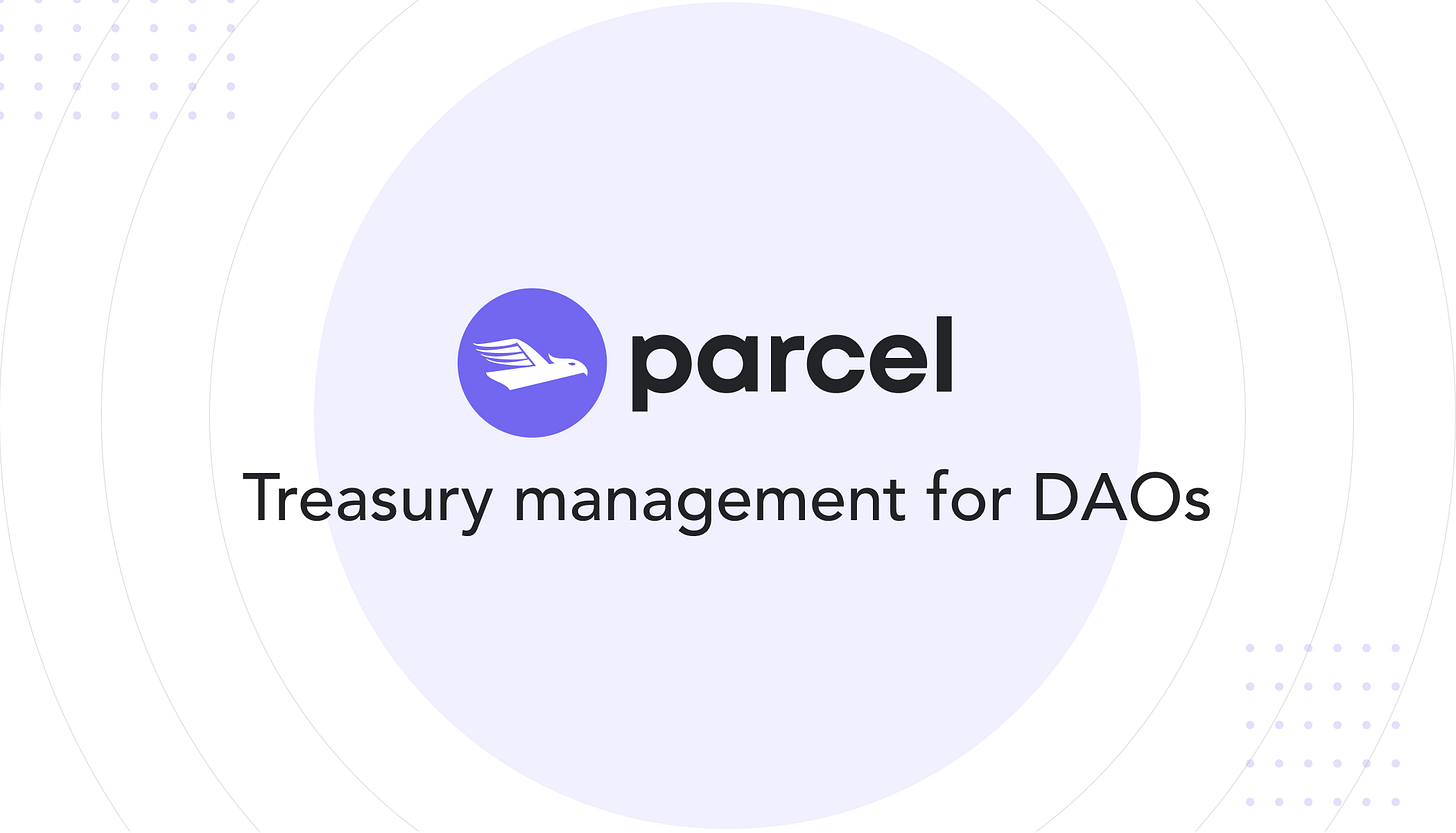Charity DAOs | State of the DAOs
You're reading State of the DAOs, the high-signal low-noise newsletter for understanding DAOs.
Gm and welcome to DAO life! DAOs have a half trillion dollar opportunity in the United States alone. With Americans donating $471 billion USD to charity in 2020, not-for-profit entities stand to improve transparency, accountability, and community leadership through the use of DAOs. What happens when you reorganize charities into systems that publicly show where each dollar is spent? Cheetah gives us a glimpse into what that world would look like.
After that, we share the TL;DR on the latest DAO ecosystem takes and thought pieces, making it easy for you to cut through the noise and stay up to date on the world of DAOs.
This is the current state of the DAOs.
Authors: Bankless DAO Writers Guild (Adi G, Cheetah, Frank America, FreedomFighter, hirokennelly.eth, Teeleroo, Thalia_M, siddhearta, Jake and Stake)
This is the official newsletter of the BanklessDAO. You are subscribed to this newsletter because you were a Premium Member of the Bankless Newsletter as of May 1, 2021. To unsubscribe, edit your settings here.
🙏 Thanks to our Sponsor:
DAOs for Charity: A Golden Opportunity!
by Cheetah

Current Overview
In a pandemic-battered 2020, Americans alone donated an estimated $471 billion to US charities. This was a staggering rise of around 5% from 2019. While donations are increasing every year, many charities only accept donations in denominations of traditional currencies. It will take some time for mainstream crypto donations to be accepted. On the hopeful side, Fidelity Charitable received $274 million in crypto donations as of November 2021. This is a progressive step, signaling the foray of crypto into charitable institutions. For example, Save the Children, one of the largest non-profits working for children’s rights and welfare, has started to receive donations in the form of cryptocurrencies and NFTs to further their cause. The Giving Block is another platform that provides hundreds of US non-profits access to tax-deductible crypto donations. DAOs may be the perfect vehicle to harness this tryst between cryptos and charities. For one, they help tackle some of the issues that are prevalent in today’s charity industry. Issues that are rooted in traditional organizational structures, such as:
Operational inefficiency. Admittedly, the level of efficiency, with respect to administrative costs and overheads, varies with different non-profits. However, it is not uncommon to see a disconnect between the money donated and the money reaching its intended audience. For instance, the Kids Wish Network lost such a large portion of its donations to operational costs that only 1-2% of it reached the kids. These non-profit costs are generally incurred due to employee and director salaries, official spaces, supplies and technology. In other words, inefficient overhead.
Corruption and charity fraud. These are common occurrences in this industry with greedy and unscrupulous executives taking an unwelcome share of the cake. In the UK alone in 2020-21, there were 1,059 incidents of fraud to the tune of £8.6m. This is in addition to the corrupt executives that have been documented to “misplace” thousands of dollars in donations every year.
Fund transfer. If you take an example of a US donation intended to be used in Africa, for instance, the movement of funds through a string of centralized banks takes days or weeks. This is in addition to the transaction fees paid to these intermediaries. Western Union and centralized banks aren’t making international money transfers easy, or affordable.
These issues have lead to skepticism regarding the expected destination of funds and lower impact of funds. It’s pretty clear that today’s corporate tactics aren’t ideal for the charity industry. So what can we do about it?
Enter DAOs
For the uninitiated, DAOs, or Decentralized Autonomous Organizations, are groups of individuals connected through a common interest. They are governed, in large part, on-chain through self-executing codes called smart contracts. Due to the very nature of DAOs, this technology offers newer and more favorable avenues for the charity industry. Blockchain technology brings value, security and innovation to the philanthropic world, which is only further enhanced by the operating structure of DAOs.
Inspired by this, Christoph Jentzsch and Marvin Maistry pioneered a Charity DAO to streamline philanthropic giving as early as 2017. They highlighted some key advantages of using a DAO structure for charity:
Code-driven: Charity DAO could be governed by two sets of code: an internal code for the DAO, and a “third-party” code which governs the DAOs relationships with third parties. Due to this, there is no room for human intervention in the DAO’s transactions and activities.
Donors on the forefront: In this setup, the donors or their elected representatives are voting members of the DAO. They stay in full control of the funds and how they are channelled to different projects. They also have the freedom to release funding based on the completion of key performance indicators (or KPIs). This ensures that the donors’ vision for the funds are met and the chances of misallocation are minimized. The additional transparency is a key feature of the blockchain and greatly needed.
Crowdfunding: We’re used to the traditional crowdfunding methods which are burdened with rules & regulations, marketing, and other legal problems. Blockchain provides an avenue to open up crowdfunding to the entire world by offering them fractional ownership. ConstitutionDAO started as a twitter meme and raised nearly $47million in short order. Charities could definitely benefit from that ability to source funds verifiably and quickly.
Governance: Here is where DAOs truly shine. DAOs enable decentralized decision-making through smart contracts reducing, or even eliminating, the need for a centralized authority. Since donors are DAO members, funds will be allocated such that undesired behaviors (which are common in corporations) are disincentivized. This allows DAOs to create cooperative/giving circles and scale them indefinitely without the need to centralize decision-making.
Transparency and Accountability: Since all the transactions happen on the blockchain, everything is publicly available. These features allow third parties to assess operational efficiency and overhead costs and gauge the financial health of the organization. They also substantially reduce opportunities for fraud and self-dealing with funds.
Lower administrative costs: Online coordination coupled with high efficiency reduces administrative costs. DAOs unlock a new layer of efficient human coordination through faster methods for communication and implementation. Taking full advantage of that, charities can lower their operating costs by a significant margin.
Ease of fund-transfer: The current system relies on a chain of banks and other intermediaries to move the funds from donors to beneficiaries. This reduces the amount that actually reaches the intended recipients. Blockchain offers a novel way to transfer funds without these intermediaries. International fund transfer becomes much easier, faster, and gets rid of unwanted processing fees paid to banks. International transactions can occur in minutes (or even seconds) and reach their destinations more quickly. Go blockchain.
Potential Issues and Solutions
If this sounds too good to be true, it’s understandable. There are still many problems that exist which may or may not be easily remedied.
First, minority token holders may be bulldozed by majority token holders who have the voting power to impose their will. While donors may be given voting rights within the DAO, there may be conflicts between them as to how the funds are disbursed. Second, there may be lazy voters who hoard voting rights but refrain from exercising them. Third, members may be misaligned with the DAO’s mission and make proposals that are contrary to its values.
These are not very difficult problems to solve and there are several solutions to address them:
Appoint curators: trusted independent members, or founding members, of the DAO who are aligned with its mission can be appointed as curators. They will identify and validate proposals, manage the multi-sig wallets, and filter proposals according to their purpose and their function to implement those that resonate with the DAO’s mission.
Incentivize voting: in a bid to combat apathetic voters, strong incentives can be offered in the form of rewards, or other perks, for active voters and participation in the proposal implementation.
Milestone payouts: to protect donations, funding can be released on an outcome-basis. For instance, a KPI-based funding scheme could be adopted where some funding can be released initially and can be supplemented upon meeting the pre-defined KPIs. This will assuage any concerns that donors might have about appropriate allocation of their donations.
Minimum quorum for voting: to ensure that proposals are aligned with the DAO’s values, establish a minimum quorum to pass proposals.
Reputation-based project allotments: projects ought to be allotted based on the reputation and experience of the proposer. This ensures maximum chances of success of projects. Organizations such as GiveWell and Charity Navigator offer a solution for gauging reputation. They provide a rating to non-profit organizations based on their impact, financial health, accountability, and transparency. Equivalent scores could form the basis of allocating funds to projects and decide the degree of funding to be released.
This is merely a partial list of potential solutions to tackle some of the issues. Financial solutions such as capping the funding per proposal and funding per month, or staggered funding mechanisms may help manage donations as well. Other solutions including options to donate without receiving voting rights could be explored if circumstances deemed it necessary.
On top of these possibilities, we are seeing numerous philanthropic and social-impact DAOs cropping up with a noble vision. Here are some of them:
Charity DAO: coordinates efforts and problem solving around crypto and blockchain applications for charitable giving
Big Green DAO: works on improving lives through nutrition security
Human DAO: aims to help people create revenue streams through P2E gaming
Klima DAO: aims to make low-carbon technologies more profitable and put a higher price for carbon usage
Thoughts for the future
Traditional charities have faced their challenges and have seen some reform in the recent past, but the overwhelming benefits of using a DAO structure (enhanced by the power of blockchain and cryptocurrencies) offer a seamless alternative for charities. A Charity DAO structure receptive to crypto donations will offer a decentralized, transparent, and secure way of handling funds. It allows the donors to be in complete control of their donations — transferred in a fast and traceable manner to allow maximum beneficiary alignment — and even restrict release schedules based on KPI metrics. Though adoption may be slow, this integration of DAOs and charities is one worth pursuing. When the road to the mountain is unfathomably distant, “just take the next step”. The first step is always the hardest, and for charities it is to embrace Web3 systems and a DAO structure for growth and development.
Actions steps
📖 Read DAOs empower social good with yield-generating DeFi products by Sarah Jansen (Cointelegraph)
⛏️ Dig into The Mirrortable by Balaji Srinivasan
🎧 Listen How Crypto Can Be Good for the Environment | Klima DAO by BanklessHQ
🙏 Sponsor: Parcel - Simplifying payouts for DAOs.
DAOs at a Glance
Hand-picked articles to understand the current state of the DAO ecosystem

The Five-Point Palm Exploding DAO Technique
Author: Anisha.eth
To create a Minimum Viable DAO (MVD) there are 5 broad concepts to consider:
North Star: What is the one-line purpose of the DAO? This one-liner should not be too broad or too specific. The North Star will form the basis of governance, of structure, and provide a guiding light when making tough decisions.
Three questions for the founding team to consider are:
a) What purpose am I trying to communicate?
b) Why do I need a DAO to achieve this purpose?
c) What is the DAO meant for?
Centralized vs Decentralized: Ensure that in order to accomplish this overarching goal, there is no need for a centralized hierarchical structure. Will governance by all DAO members truly play the defining role in all of the DAO’s actions and choices? The answer to this question has to be “yes” for it to truly be a DAO.
Logistics: Logistics and Operations will look different in each DAO but there are some common elements such as managing the treasury, discord (or platform of choice), legal protections, and bandwidth. The questions to ask are “Have the requirements to accomplish this “North Star” been identified?” and “Are they feasible?"
Narrative: What is the narrative that will bring DAO members together? This narrative will keep members of the DAO aligned and ensure consistent communication, internally and externally. This is an expansion of the North Star.
Lifespan: Will this be a DAO that exists for 2 months, 1 year, or forever? Not all DAOs are meant to last forever. DAOs that last beyond the length of its productive life will drain the community’s energy, time, and resources.
Who will own the creator economy? A web2 vs. web3 showdown
Author: Justine Moore
After a decade of inaction, web2 platforms have finally realized the need to help their creators make money. Meanwhile, web3 platforms are pioneering a new form of monetization. These web3 platforms empower creators to own their audience and enable fans to financially benefit from the creator’s growth.
In the past, web2 social platforms took a “hands off” approach to creator monetization. This changed in 2020 when Tiktok announced its creators fund which pays users from its balance sheet. Other social platforms followed and allocated funds to pay creators. However, most social platforms don’t want to pay for content forever. Now they’re building features that allow creators to directly monetize their audiences.
One question is “Do consumers actually want to pay the creators for extra content or special access?” However, the bigger question is whether or not the fan/creator relationships on web2 social apps are a fit for more active forms of monetization.
Web3 platforms argue that layering creator monetization on top of existing social apps is the wrong approach and that web3 platforms will provide a better model for creators to capture value from their creations. They allow creators to truly own their audiences, without the interference of a centralized authority, and enable followers to invest in the creator’s future success.
Fans invest to “own” a piece of the creator’s content and the creator makes money from the original sale of the asset or token. Fans are rewarded for being early supporters and can trade their ownership on secondary markets, if they choose.
The vision is compelling, but there are challenges in execution. Two that stand out are
Aggregation and Discovery: How will artist be discovered outside centralized platforms?
Consumer Experience: The UX of most Web3 products is still far too complex and intimidating for mainstream consumers.
'We're Freaking DAOing It': The People Who Think DAOs Are the Future of Work
Author: Jeff Wilser
We hear a lot about how DAOs are the future of work, but what does working in a DAO actually look like? For some, it’s waking up early, sliding into Discord, skipping meals, and putting in the time until sleep, only to do it again the next day. And they do it again because it’s exhilarating, and some hope, profitable. DAOs are so appealing to some because of:
Start-up Culture. DAOs take the best parts of start-up culture and create a mix of adrenalin, mission-driven focus, creative and interesting work, and an opportunity for wealth, to fuel and incentivize a community.
Great Perks. Contributors enjoy a flexible schedule, a collaborative work environment, a sense of passion & purpose, and a community ownership model that many contributors find irresistible.
Monetization. Builders and creators get paid for the work they do.
DAOs are flatter than traditional organizations, but they are not without structure. Some DAOs have work streams to coordinate activity, and their operations look more like a normal business than you might think, with meetings, memos, and deadlines. The big difference: blockchain-enabled incentives. DAOs are a curious mix of socialism and capitalism, but:
DAOs are not decentralized because it’s common for a small group of people to hold most of the token.
DAOs are not autonomous because they are created by humans with biases.
DAOs are not organizations because they are a type of technical infrastructure.
Whether you disagree about what a DAO is, research suggests that those who contribute to them enjoy themselves, but whether this enjoyment comes from the work or the allure is harder to discern. One thing we can agree on: remuneration is uncertain. Salaries are rare, and most people are paid per project or bounty. Such uncertainty may be no different from the regular gig economy: work is plentiful and there doesn’t appear to be much concern for job security. If DAOs sound like an organization of in-demand freelancers, you could be right, and it’s up to DAOs to ensure that they become something more than just that.
DAOs Aren’t A Fad — They’re A Platform
Author: Jeff Kauflin
Recently, Flamingo DAO pooled $10 million to buy a collection of CryptoPunk NFTs. Despite some concerns and issues with their members, they sprung for the collection which was valued at $30 million. Underneath all this noise, a new model of organization is emerging as an alternative investment vehicle: DAOs.
Admittedly, DAOs started off rockily but they have come a long way, holding a whopping $8 billion across their treasuries (at time of writing). DAOs have also been involved in many ambitious initiatives; Krause House DAO, for instance, is planning to buy an NBA team!
Many DAOs are limiting membership numbers to creatively skirt SEC rules, thanks to the age-old “investment club” exemption. Having said that, DAOs allow people interested in alternative investment opportunities to avoid the asset management industry’s exorbitant fees. DAOs are nimble LLCs that allow efficient voting, profit sharing, and liquidity supply.
Tribute Labs funds all its DAOs in ETH and secures it with the blockchain. They have also implemented governance and voting safeguards to ensure true decentralization.
Currently, the global money asset management is handling $100 trillion in assets. Syndicate co-founder, Ian Lee, estimates that DAOs will hold at least 2% of that. Jess Sloss, who runs start-up workshops and transitioned to this space from the web2 world, says that while people create massive value for these companies, they have little to no say. DAOs are a platform to escape this toxic organizational model.
Ecosystem Takes
🔥 and 🧊 insights from across the DAO ecosystem
Our Decentralized Selves: Creating in a Post-Identity Future
Author: ItstheElword with rafathebuilder
🔑 Insights:
Web3 enables a post-identity landscape where creators enjoy the freedom and empowerment of discarding their past. In realms where revealing one’s identity is linked to responsibility, the pseudonymous individual is at a disadvantage. However, the choice to blur lines by wearing a mask in some scenarios and removing it in others is becoming the norm, with plenty of cultural examples to reflect that masking is more common than we think:
In BDSM, pseudonymity is evidence of a commitment to its culture and practice.
The participation of creators like Banksy and Satoshi is enabled by their hidden identity.
Limited companies protect owners from liability, allowing them to fold and reincarnate to take on a new purpose.
Token Engineering is the Future of Organizational Design
Author: Gideonro
🔑 Insights:
Modular token engineering can help us create new crypto-economic primitives that can be reused and integrate with new services. Token engineering can serve to help us iterate on technology faster and build better ways to organize ourselves.
It decentralizes computing so that big web companies cannot act as gatekeepers for economic transactions. This helps to level the playing field by redefining the notion of value in economic networks. Now we can to harness the tools provided by blockchains to accelerate organizational design.
In order to do that, modularity acts as a remarkable force for novelty. Blockchain modularity in the form of tokens, smart contracts, and other organizational processes are powering the future forms of organization, such as DAOs.
Token engineering is the interdisciplinary practice for creating blockchain modularity. By itself, it will not create the changes we need, in fact, it can often be used to concentrate wealth and power. Therefore, we need to invest in things like governance, community, and culture to change how we organize humanity.
DAO Challenges presented by Tally
Author: Leticia Bovino & Delleon McGlone
🔑 Insights: DAOs are an ever-growing ecosystem with many opportunities and challenges that will evolve over time. DAOs and their members must be equally aligned for sustainability, longevity, and success. If DAOs don’t have accountability, consistency, or transparency, then they can’t expect their contributors to be accountable, consistent, and transparent either.
The core culture, values, and processes of a DAO should be open source to enable all contributors to be informed, educated, and self-resourced.
The next 10 years of DAO-ing belong to Minimum Viable Communities (MVCs, i.e., does the DAO’s original purpose and value prop still hold true, regardless of change); DAO tool integration (the tools are consistent across different DAOs); critical infrastructures (members’ level of communicating & organizing skills); up-to-date how-to guides; and automation.
DAOs need feedback loops on completed projects to better understand what went well and what could be improved.
Creator Economy - Potential trojan horse of web3?
Author: doorvesh_eth
🔑 Insights: The new creator economy could be what brings Web3 to the mainstream. The benefits are massive: creators get to keep ownership of their products, retain their profits, and utilize new ways to share their content through NFTs.
To make money in Web2, creators a few options. A musician could list their music on SoundCloud or Spotify, but artists will need to get 2.5 million streams on Spotify just to attain a minimum wage. People could post on TikTok and access the TikTok Creator Fund, but even one of the top TikTokers, with 67m followers and who gets 20m views per week, only receives $23 per week.
In Web2, the corporations receive money first and pay the creators last. In Web3, the creators can interact with their fans directly, receive the payments directly, and promote content directly. No middlemen taking 99.9% of what is due to the creators.
In Web3, not only do the creators get ownership of their work, but so do the fans. Now, creators can transform their images, songs, and videos into NFTs, and continue to provide NFT owners with a share of any profits made from the underlying content.
How to Get the Hottest Crypto Jobs: Start by Working With a DAO
Author: Charlie Wells and Claire Ballentine
🔑 Insights:
Crypto is influencing the way people enter the job market. The value in attaining crypto-based skills and experience as the space expands and the demand grows. The world of crypto levels the playing-field of attaining work because it does not discriminate by age, gender, or race.
The typical route to landing a good job has changed. It used to be that undergraduates would “Lock down summer internships by sophomore year — maybe junior at the latest — for a top firm to even consider an offer after graduation. Then contend with years of long nights, countless PowerPoint presentations, Excel jockeying and junior vice presidents with a tendency to say things like, ‘Don’t think, just do.’”
There are increasing numbers of undergraduates that recognize the exponential growth in crypto, so instead, take summer internships in DAOs to build up their experience and credibility in the field for when they graduate.
From 2020-2021, the finance and tech industries grew by 100% and 98% respectively, whereas crypto jobs grew by 395%.
DAOs are the great equalizer. In DAOs, it doesn’t matter whether you went to Harvard or didn’t even study at college. It doesn’t matter whether you are 22 or 62. Your skin color doesn’t matter, your gender doesn’t matter, and your location doesn’t matter — DAOs are open to everyone.
DAO Spotlight: Index Coop
The Index Cooperative is a community of finance professionals, engineers, DeFi experts, meme-makers, content marketers and crypto enthusiasts focused on making crypto investing simple. The Index Coop is on a mission to build a globally distributed, community driven and owned asset manager, powering a range of index products which help anyone with a wallet or address gain access to a range of crypto investment themes. They want to help everyone benefit from the rising tide of crypto innovation.
The Index Coop has launched several products that were released in collaboration with BanklessDAO. These include the BED index and the GMI index. The BED index is a product that holds the assets Bitcoin, Ethereum, and DPI in equal parts. This allows you to get the stability of the largest crypto protocols and exposure to DeFi. The GMI index focuses on high growth, early stage DeFi projects which are not yet considered “blue chip”.
Are you interested in getting involved? Follow @indexcoop on Twitter, join the Discord, or complete their first quests! Go to indexcoop.com to learn more!
Get Plugged In
Event Highlights
🌄 ETHDenver - February 11-20, 2022 - ETHDenver is a member-owned Community Innovation Festival. With the genesis of SporkDAO in June of 2021, ETHDenver is the first event-based DAO in the world. The ETHDenver #BUIDLATHON is about bringing diverse creativity around a common purpose. Distributed computing is the future and Colorado is a leading community supporting this emerging technology. Our event empowers participants to shape this new world, while cementing the Rocky mountain region and the State of Colorado as a thriving hub of Ethereum and blockchain innovation.
🏔 DAODenver - February 15-16, 2022- We're going to Colorado, come with us! What will be one of the biggest DAO events is coming in February alongside ETHDenver. Two full days of discussions with the most influential DAOs and DAO leaders, helpful community-run workshops, and great VIBEZ! Whether you want to learn more about evolving DAO governance models, or how to be a better collaborator, DAODenver will have it all. This event is completely DAO-led and managed! All proceeds go to DAODenver organizers and DAOists.xyz treasury with the goal of providing free information and best-practices for DAOs.
Event info:
🎟️ Tickets
💰 Sponsor
🏝 Permissionless Conference - Tickets are on sale for one of the biggest DeFi conferences! Over 5,000 people will be attending in total and every two weeks 250 more tickets unlock. Once 250 tickets are purchased, registration closes and you’ll have to wait until the next release. Speaking of the next release, prices are currently at $967 and almost sold out. Speakers include our very own Ryan Sean Adams and David Hoffman, as well as many others. Join us on Tuesday - Thursday, May 17 - 19, 2022 in sunny Palm Beach, Florida for the event.
🧳 Job Opportunities
Get a job in crypto! Do you like solving hard problems, care about building more efficient markets for everybody, and want to work at the frontier of decentralized finance? KeeperDAO is looking for full time contributors, with salaries ranging from $169,000-$722,000. There are positions ranging from engineering, recruiting, product marketing, copywriting, and design. Sound interesting? Sign up for our referral program and go full-time DAO.
Solidity Developer
Sr. Backend Engineer (Python)
Frontend Engineer (React/Typescript)
Technical Recruiter (❌ technical)
PeopleOps Lead (❌ technical)
Sr. Product Marketer (❌ technical)
Sr. Copywriter (❌ technical)
Sr. Community Manager (❌ technical)
2D Graphic Designer
Quantitative Analyst
On-chain Data Specialist
🙏Thanks to our sponsor
Parcel
Parcel is a treasury management and payments tool that helps to manage payroll, expenses, grants, airdrops and more for a DAO. Parcel works with over 200 DAOs, including prominent ones like IndexCoop, BanklessDAO, Synthetix, Compound Grants, and Aave Grants DAO.
Scaling financial operations for DAOs is a challenge, especially when there are multiple contributors with varying levels of contribution. Parcel helps to get rid of the spreadsheets with contributor management, 1-click mass payouts and automated recurring payouts.
👉 Our website: https://parcel.money/
👉 Join our Discord.
👉 Follow us on Twitter.





